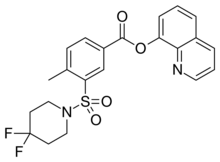2F-QMPSB (SGT-13) is an arylsulfonamide-based synthetic cannabinoid that is a fluorinated derivative of QMPSB and has been sold as a designer drug.[1] Its identification was first reported by a forensic laboratory in Italy in January 2019,[2] and it was made illegal in Latvia shortly afterwards.[3][4] Fluorination of the tail group is a common strategy to increase potency at cannabinoid receptors which is seen in many related series of compounds.[5][6]
 | |
| Legal status | |
|---|---|
| Legal status |
|
| Identifiers | |
| |
| CAS Number | |
| PubChem CID | |
| ChemSpider | |
| UNII | |
| CompTox Dashboard (EPA) | |
| Chemical and physical data | |
| Formula | C22H20F2N2O4S |
| Molar mass | 446.47 g·mol−1 |
| 3D model (JSmol) | |
| |
| |
See also
editReferences
edit- ^ Tsochatzis ED, Alberto Lopes J, Holland MV, Reniero F, Palmieri G, Guillou C (2021). "Identification and Analytical Characterization of a Novel Synthetic Cannabinoid-Type Substance in Herbal Material in Europe". Molecules. 26 (4): 793. doi:10.3390/molecules26040793. PMC 7913736. PMID 33546439.
- ^ "NPS2019". Belgian Early Warning System on Drugs (BEWSD).[permanent dead link]
- ^ Centre for Disease Prevention and Control (17 January 2019). "Par aizlieguma noteikšanu vielai 2F-QMPSB un tās saturošiem izstrādājumiem" [On the Prohibition of 2F-QMPSB and Articles Containing It]. Latvian Journal: Legal Acts of the Republic of Latvia (in Latvian).
- ^ "Уважаемые эксперты" [Dear experts]. Aipsin Drugs (in Russian).
- ^ Banister SD, Stuart J, Kevin RC, Edington A, Longworth M, Wilkinson SM, et al. (August 2015). "Effects of bioisosteric fluorine in synthetic cannabinoid designer drugs JWH-018, AM-2201, UR-144, XLR-11, PB-22, 5F-PB-22, APICA, and STS-135". ACS Chemical Neuroscience. 6 (8): 1445–58. doi:10.1021/acschemneuro.5b00107. PMID 25921407.
- ^ Yang SW, Smotryski J, Matasi J, Ho G, Tulshian D, Greenlee WJ, et al. (January 2011). "Structure-activity relationships of 2,4-diphenyl-1H-imidazole analogs as CB2 receptor agonists for the treatment of chronic pain". Bioorganic & Medicinal Chemistry Letters. 21 (1): 182–5. doi:10.1016/j.bmcl.2010.11.044. PMID 21115245.